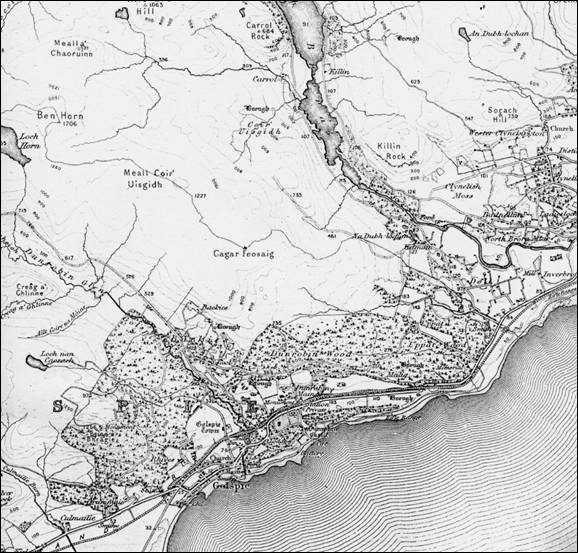
| Overview-Melvilles |
THE MELVILLES OF THE DOLL AND RELATED FAMILIES
An
Overview
My ancestors on
my mother’s Melville side of the family originated, as far back
as I can get a location identified with certainty, in the parish
of Clyne and more particularly in the
It is said that the
Melville name comes from the barony of Malaville or Malleville
in the Pay de Caux,
In my family history writing I have used the modern spelling, Melville, in most instances so as to avoid confusion but note on my database of information and text how the name was recorded in the official records and on memorials. Other names, in addition to Melville, have been standardised too and this again purely to aid understanding and for convenience. Though at times Sarah was spelt Sara and Mackay variously spelt as McKay, MacKay and Mackay I have generally used a consistent form, namely Mackay.
What brought the
Melvilles to East Sutherland is unclear and it is not certain when
they first arrived. The Melville lands are, in the main, in the
central and southern parts of
Before my research the Melvilles were generally thought to have been a small family who came into the area in the late 19th century but both assumptions have been proven to be wrong. The family became very widespread 19 and 20th centuries in the parishes of Golspie and Brora and there was much inter-marrying with other ‘local’ families and incoming Border families associated with the introduction of sheep at the time of the Sutherland Clearances. There was also a considerable amount of inter-marrying between Melville cousins in the various family lines. Between the four lines considered to be the principal descents from a small nucleus of early ancestors there are considerable numbers of inter-connections. The closest and most obvious are best outlined in diagrammatic form though even then much study of charts is required to understand those relationships and identify other less obvious inter-marriages.
Below
a map of the area where the Melvilles were most prominent.

The following diagrams identify the main Melville lines and the possible earlier structure leading to a common ancestor or family group with a close relationship to one another. The evidence so far uncovered suggested that a William Melven could be the progenitor of the main lines in the Doll area in which I have an interest and there is the possibility that this individual was also the father of a number of early female Melvilles whose parentage has not been apparent from the available records. In my Melville database those females are listed under the family of ‘? Melven’ but it is possible that William Melven and ‘? Melven’ are one and the same person.
Even if William Melven (Wilam Melven and Ana Sutherland on their gravestone) are not the originators of all the Melville lines the Melville families are, nevertheless, all inter-related. The diagram below shows just a few of the more obvious linkages between the different families and groups. There are many other inter-marriages between the families in Doll and Brora with such a complicated structure that producing the situation diagrammatically on one chart is quite impossible.
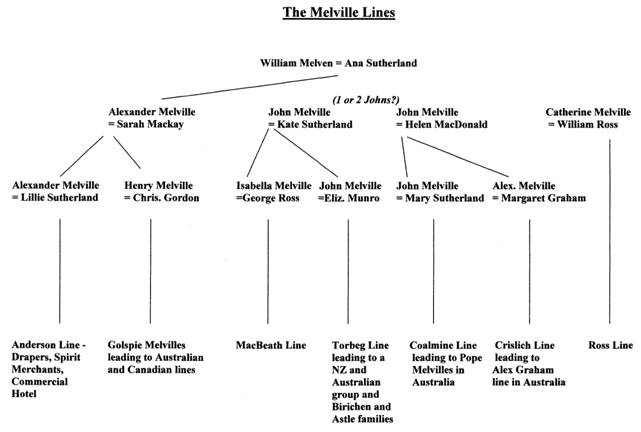
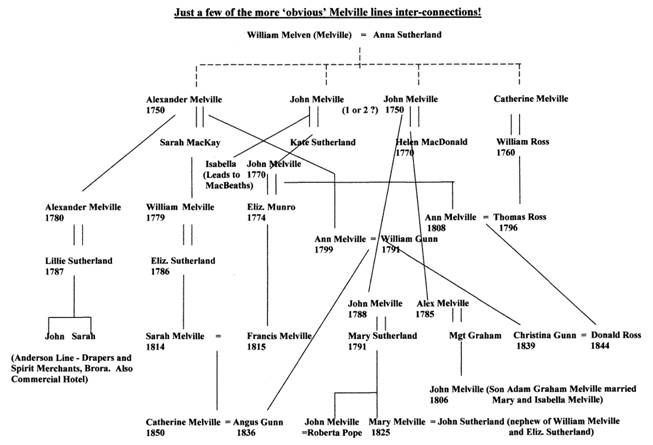
The very early Melville
burials that can be identified are in Golspie cemetery and it is
later that memorial stones to Melvilles appear in Clyne cemetery
and the Clynekirkton graveyard. Those
early burials are almost totally in the same area of the Golspie
cemetery in an area half way from St Andrew’s Church and the
outer wall and in a direct line towards the top end of
It would appear that though Doll was in the parish of Clyne the majority of burials took place in the grounds of St. Andrew's Church in Golspie. Despite the longer distance to Golspie and the more undulating route it is said that the families of the dead were happier to go to the extra effort rather than cross the River Brora. The Clyne cemetery was, however, not the one presently in use and the further distance to the old burial ground at Clyne Kirkton might have been a factor. An earlier George Melville (b. 1803) and some members of his family and descendants are buried in this Clyne Kirkton cemetery near where he farmed.
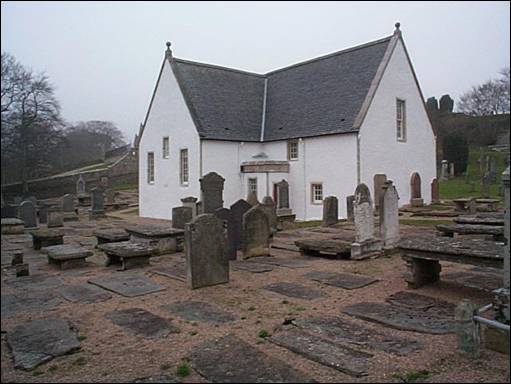
Above the area
of Golspie cemetery where the majority of identified Melville
graves from the 19th century are
located. In
the background is St Andrew’s Church and beyond the wall
separating the cemetery from the school grounds.
The majority of the Melville gravestones in Golspie were not very obvious until they were unearthed and cleaned by members of a voluntary team in the 1980s. The writing on the upright stones was cleared of algae and flat stones were found beneath turf. All the stones except two can be linked directly to known family members. One flat stone closely associated with vertical stones in the same plot is that of William Melville (Melven) and Ana Sutherland and it is this comparison of names and position of the stone has lead to the belief that this could be the parents of my first certain ancestor, Alexander Melville of Brora and Doll.
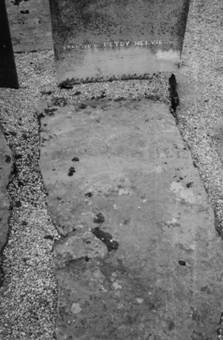
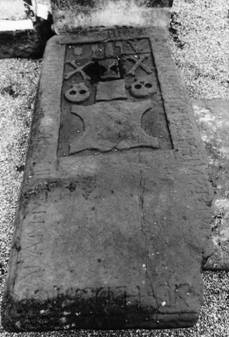
The William Melven and Ana
Sutherland Stone and the Adam Melven and Elizabeth Elphinstone
Stone in
Nearby is a flat table stone with a
considerable amount of carving upon it and some names and
writing on it were easily discernible after cleaning though
within a year or two the deterioration in the state of the stone
was significant. This
stone seems to pre-date all the others and is a memorial to Adam
Melvin and Elizabeth Elphinstone. After some work, and with knowledge of local names
I was researching, it was relatively easy to read the almost the
full inscription, ‘ Here lyes the dust of Adam
Melvin who departed this world (date unclear) and his spouse
Elizabeth Elphinstone’. Unfortunately
the corner with the important date is badly worn and partly
broken away. All
efforts to enhance the inscription, including an
attempt to enhance a photograph of the damaged corner, have failed and
there is little likelihood of it providing further information. Position within the cemetery, stone type and the
inscription suggests that the memorial is from the 17th century
and marks the last resting place of a couple of no little means. It also
represents a family who had a tradition of marking graves with a
stone of some distinction and possibly even a family who brought
such a cultural outlook with them from elsewhere. While this
stone is not the only one of a table type in this area of the
cemetery it is fair to say that there are few stones of its kind
and it appears to be one of the oldest of its type in the burial
ground.
The name Adam does not seem to appear
again in the Melville family except in the interesting marriage
between Melvilles in
In the tidied
Golspie cemetery I came across two interesting fragments of
stone. One
engraved Alexr Melvin, about 2 feet by five feet but irregular
in shape, and the other engraved Hector Melvin. The latter
stone also had the name Katr engraved on it. They were
situated about 30 yards from the bulk of the Melville stones but
the second mentioned of the fragments might have been out of
place. It was about 2-3 feet square had been placed between
other, larger existing stones.
It is obviously possible that this was the Alexander of Alexander and Sarah but no proof exists. To my knowledge, the name Hector is only found, in early times, in one instance in the Melville family of the Doll but it is found in the Melvilles who lived 12, or so, miles away in the Portgower area of Kildonan parish. Some of those Melvilles have only been indirectly connected to the Melvilles in my study.
The two isolated stones, particularly the fragment belonging to Hector, since looking a little out of place where they are may are probably not be in their original positions though it has to be said that this area of the burial ground has stones from an early period. They are not particularly soundly anchored, even allowing for being flat, and the stone to Hector is not of the same colour as those around it. It is possible that those stones have been moved at sometime in the past and possibly even when the cemetery was extensively cleaned in the 1980s by the voluntary group. This group did an excellent job clearing away the turf which had hidden so many of the stones. After this had been done black polythene was laid and stone chips put on top. I am told that some stones were lifted and that some actually had the inscription on the bottom side. This inscription, it was said, could be read as clearly in the soil as an imprint as on the stone.
The clearing of the
ground and the cleaning of stones enabled myself and other
family historians to collect information that had been hidden
for decades. A
negative side, however, of the work is the fact that some of the
stones cleaned have now deteriorated to such an extent, due to
weathering, that they can no longer be read.
The Golspie cemetery,
amongst many others, has had its memorial inscriptions surveyed
by A S Cowper and I Ross and published by The Scottish Genealogy
Society. Those
recorders put in much work in a labour of love and produced an
excellent gravestone record for future generations. Their work
is generally very accurate and it is only where stones have been
very difficult to read or have had family information which has
been particularly difficult to interpret that errors have crept
in. In
my work I am only aware of one stone where a significant amount
of potentially important family history data has been
overlooked. This
being the much carved table stone to Adam Melvin and Elizabeth
Elphinstone.
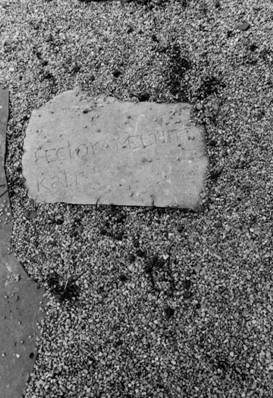
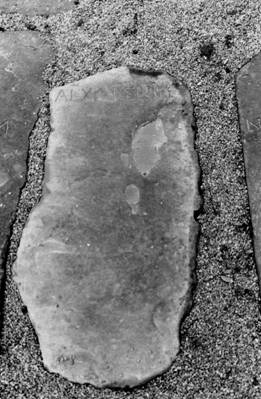
Close to where the
fragments of stone were found I noted more recent stones in a
Ferguson plot with a Margaret Melville (b. 1818) on one of them. This
Margaret was the daughter of Henry Melville (B. 1790) and
Christina Gordon (b. 1797) and she was the wife of John Ferguson
(b.1804) who worked as a farm servant. John
Ferguson's family lived at Rose Cottage, Golspie and one of his
sons became a tea planter in
Henry's son
George, mentioned above, married a Margaret Grant, daughter
Euphemia married William Turner and son William married twice
and founded an Australian branch of the family. His first
wife was Annie MacDonald whom he married in
Returning to the flat
table stones, there are some interesting points and questions
regarding the ‘whys and whens’ of some of those memorials. Apart from
the Adam Melven table stone there is another table stone to
Alexander and Lillie Sutherland. This is an
impressive but later memorial erected to a Brora merchant and
his wife. Now
at first it is a puzzle as to why they are in Golspie cemetery
but examination of the OPRs gives some clue. Their two
children were born in ‘The Dole of Brora’ and this would seem to
suggest that this Alexander, though not yet identified with
certainty as being in my Melville lines, was, nevertheless, a
member of the family of the Melvilles of the Doll. His most
likely place in the scheme of things is in the family of
Alexander Melville and Sarah Mackay. There are a number of
spaces in this couples births and it is almost inconceivable
that they would not have followed naming pattern tradition and
had an Alexander.
There were, in fact,
three Alexander Melvilles having family in the Doll area at the
same time. The
first, and very certainly in my main line, was Alexander
Melville who was married to Sarah MacKay. His first
children were born in Brora but from about 1800 he was having
children in the Doll. In an OPR
entry he is described as Alexander Melvin ‘Forry’ and this was
clearly a by-name to distinguish him from the other Alexanders. The second
was Alexander who married Lillie Sutherland and his by-name
appears to have been ‘Drumer’. I am not
sure if this was a mis-spelling and he was indeed a drummer. And
finally Alexander Melville of Crislich, whose spouse was
Margaret Graham, was designated ‘Sergeant’.
The former’s descendants
are well documented in the
reference section of my family history and the latter’s descent
now seems clearer since the discovery of Alexander and
Margaret’s son, John, in Edinburgh and his descendants in
Australia. This
connection to the main line is documented later and suffice to
say, at present, it is very clear that this Alexander is in the
centre of the Doll Melville group but exactly where is still to
be determined. The
very fact that he married two sisters from the ‘Coalmine’ line,
his ‘cousins german’, indicates his closeness to the Melvilles
of the Doll.
One of the biggest
puzzles in the Melville genealogy involves the number of
Melvilles named John who crop up in the OPRs and the statutory
records. At
first it appeared that there were either many more branches of
the family in existence in the second half of the 17th century. However,
this is not entirely born out by other evidence albeit that it
is fairly circumstantial.
There are three major
lines apparently originating from a John Melville. One leading
to the ‘Coalmine’ Melvilles from John Melville and Helen
MacDonald, another leading to McBeaths in the Doll from John
Melville and Kate Sutherland and another to the ‘Torbeg’ line
from John and Elizabeth Munro. At first
glance there are too many Johns and there is the impression that
they are all of a similar age. However,
the OPRs give some guidance on the matter if read carefully and
if naming conventions are considered and places of birth are
taken into consideration it is possible that there were just two
Johns of different generations. However,
since family tradition in
The family of John and
Kate are key elements in the Melville structure as they had a
John and an Isabella but also probably an Alexander and maybe
other children besides. Clearly, Alexander Melville who married
Lillie Sutherland or Alexander who married Margaret Graham are
possibilities and there are a number of unidentified female
Melvilles from the second half of the 18th century who are
contenders. Naming
patterns suggest that they are members of the family being
researched and that some, if not all, are from the family of
William Melven and Ana Sutherland. It
is interesting to note that the sons of Alexander and Lillie and
Alexander and Margaret who would by tradition be named after
their paternal grandfathers are, in fact, John. This
theorising leaves a number of possibilities relating to the
positions of the Alexanders and the Johns.
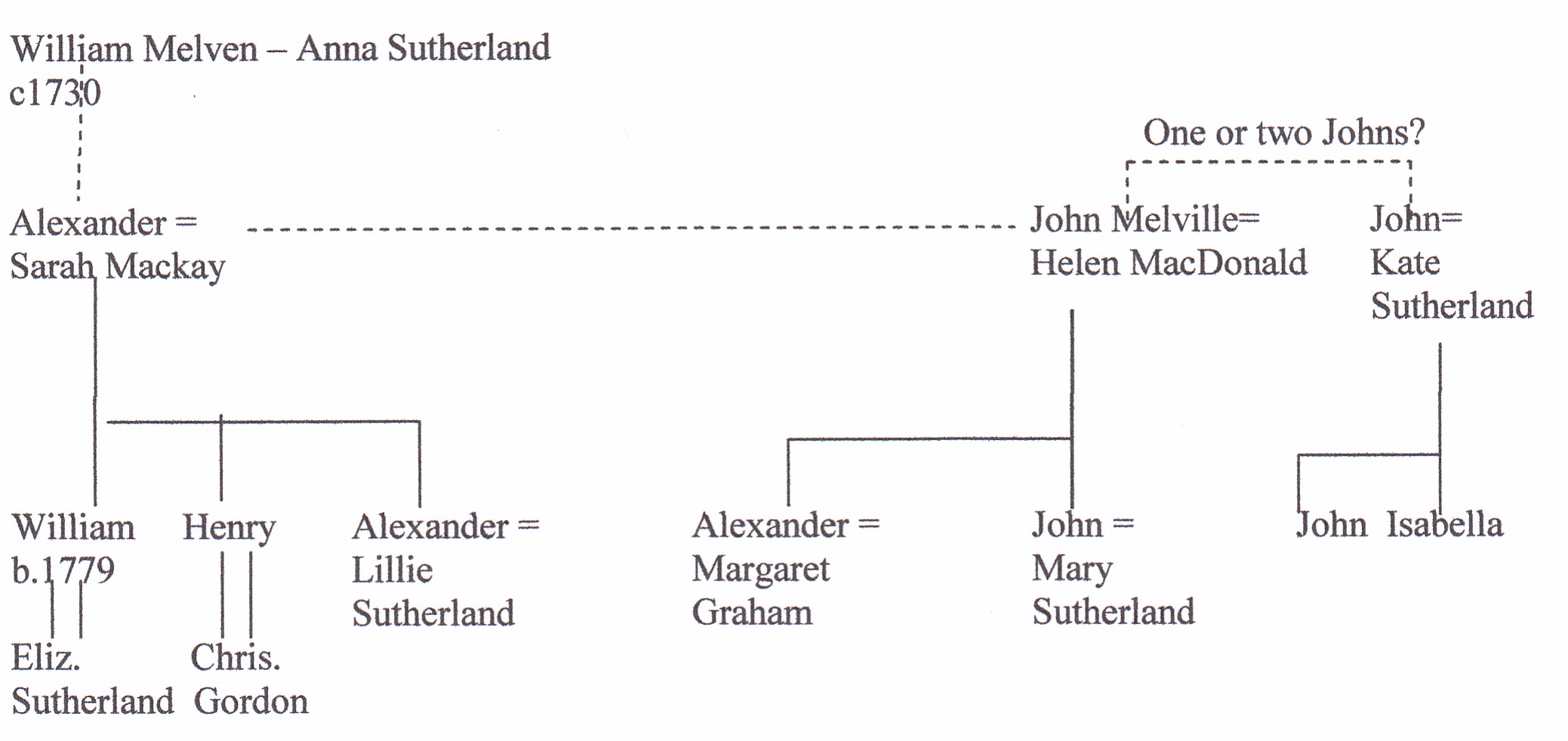
1. Since Alexander and Sarah had William as their first child by naming pattern then Alexander’s father would have been William.
2. Alexander and Sarah surely had an Alexander though not directly found. Place in the tree can be speculated upon with some degree of confidence due naming patterns of Alexander and Sarah's family and that of Alexander and Lillie. Also the places of residence and births of children at various times adds to the likelihood that the Alexander married to Lillie Sutherland came from this line. Finally the placement of the other Alexander who married Margaret Graham in a different line is further evidence.
3. It is very likely that Alexander ‘Forry’, husband of Sarah Mackay had a brother John.
4. Sergeant Alexander Melville and Margaret Graham named their first son John and, as will be seen in the next paragraph, had a grandson who married two sisters who were the grandson's cousins This leads to the conclusion that JohnMelville and Helen MaDonald were Sergeant Alexander's parents.
5. Alexander
and Margaret's grandson, Alexander Graham Melville, married
Isabella and Mary Melville. They were sisters and he described
them as ‘cousins german’. This would
normally indicate them to be first cousins though second cousins
in the direct male line is also a possibility. They could
not have been first cousins but they could be second cousins in
the male line if Alexander Melville who married Margaret Graham
and John Melville who married Mary Sutherland were brothers. In
other words they came from the John Melville and Helen MacDonald
line. Family
relationships, dates and other circumstantial evidence makes
this very likely.
Returning to Adam, his
place in the scheme of things may never become clear. As stated
earlier, it is very unusual to find such an early ancestor with
no one named after him. He may not
be a member of the family in which I have an interest or the
child/ren named after him may have died young. However,
from the placing of his gravestone he is likely be a member of
the family being researched and from the type of stone it is
possible he was one of the earliest ancestors in the area. Despite
this the earliest identified likely ancestor is William Melven
and must remain so until further evidence can be found on Adam.
What can be safely said is that the Melvilles from Golspie and Clyne grew in number from a relatively small group of people, possibly one or two families, in the late 17th or early 18th century to a world-wide family inter-related by inter-marriage but also with clearly definable descent lines.
The Golspie Melville Line – My ‘Mainline’ Melvilles and a few connected families
This family report section reports briefly on the Golspie Melvilles and dips into some of the related and interesting Melvilles For more detail on those Melville families and many other Melville lines it is best to read the more detailed family activities and the database descent lines.
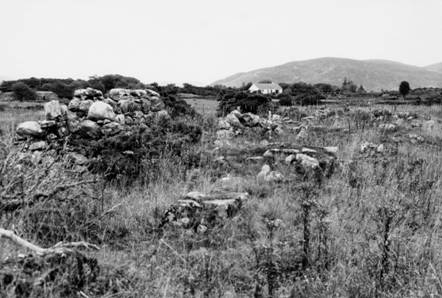
All that was left in the 1980s of the house George Melville (1875) was born in at the Doll.
One further
snippet of information about John Ross is that he had a brother
Daniel (Donald maybe) who went to
Christina Ross
later married George Ross (b. 1854), blacksmith of Rosehall and
Brora, and had a large family to him before he went to
George Melville was also illegitimate. His father was John Melville (b.1854), a farm worker from Strathsteven in the parish of Golspie, the son of a horse breaker and coachman. John later married Margaret Munro (b.1861) from Lairg and they had nine children born at various farms in East Sutherland where he worked. George's mother was Catherine Sutherland (b.1854), known as 'Kate Roy', from the Doll. Catherine never married and as far is as known she had no more children. She died in the poorhouses at Mosshill, Brora in 1925 having been put there after her house in the Doll burnt down. It is said that she left some herrings in a covered pan on the fire to cook while she walked to Brora to the sacraments at the Free Church and while away the thatch caught fire. While the herrings story cannot be verified it is true there was a fire and as a pauper she had no alternative to move to Moshill.
Kate was interred in the old part of the Golspie cemetery near the wall separating the burial area from the primary school grounds. The grave is unmarked but was shown to me by my uncle Neddie (Janatus) Melville shortly before his death. He was present at the funeral and remembered the place of the grave. This grave is in the same section of the burial grounds as the graves of the Melvilles of the Doll but is some distance from their lairs. It is likely that Kate was buried with her parents as there were few new lairs available in this section of the burial ground.
The direct line from my mother through, George (b. 1875), John (b. 1854), John (b. 1821), Henry (b. 1785) and Alexander Melville (b. c1755) takes us back to the mid-18th century. This line has the other related lines outlines above running parallel with it. One is headed by a John Melville and Kate Sutherland and also originates in the middle of the 18th century and, as earlier noted, there is the likelihood that John and Alexander were brothers. However, as both lines are joined at an early stage by the marriage of Sarah Melville (b. 1814) and Francis Melville (b. 1815) even if there had been no prior relationship they can be legitimately incorporated into the overall family tree just as other lines can too. Sarah's parents were William Melville (b. 1799) and Elizabeth Sutherland (b. 1786) and Francis's parents were John Melville and Elizabeth Munro. This John Melville may have been the son of an earlier John Melville who may have married twice or had children to two different women. Firstly to Kate Sutherland and later to Helen MacDonald though dates of births of children to those individuals tend to make such a supposition hard to sustain without evidence of actual birth dates.. Evidence for those marriages or liaisons and the relationship of the Johns is thin being circumstantial, by way of the study of OPRs, through naming patterns and family tradition.
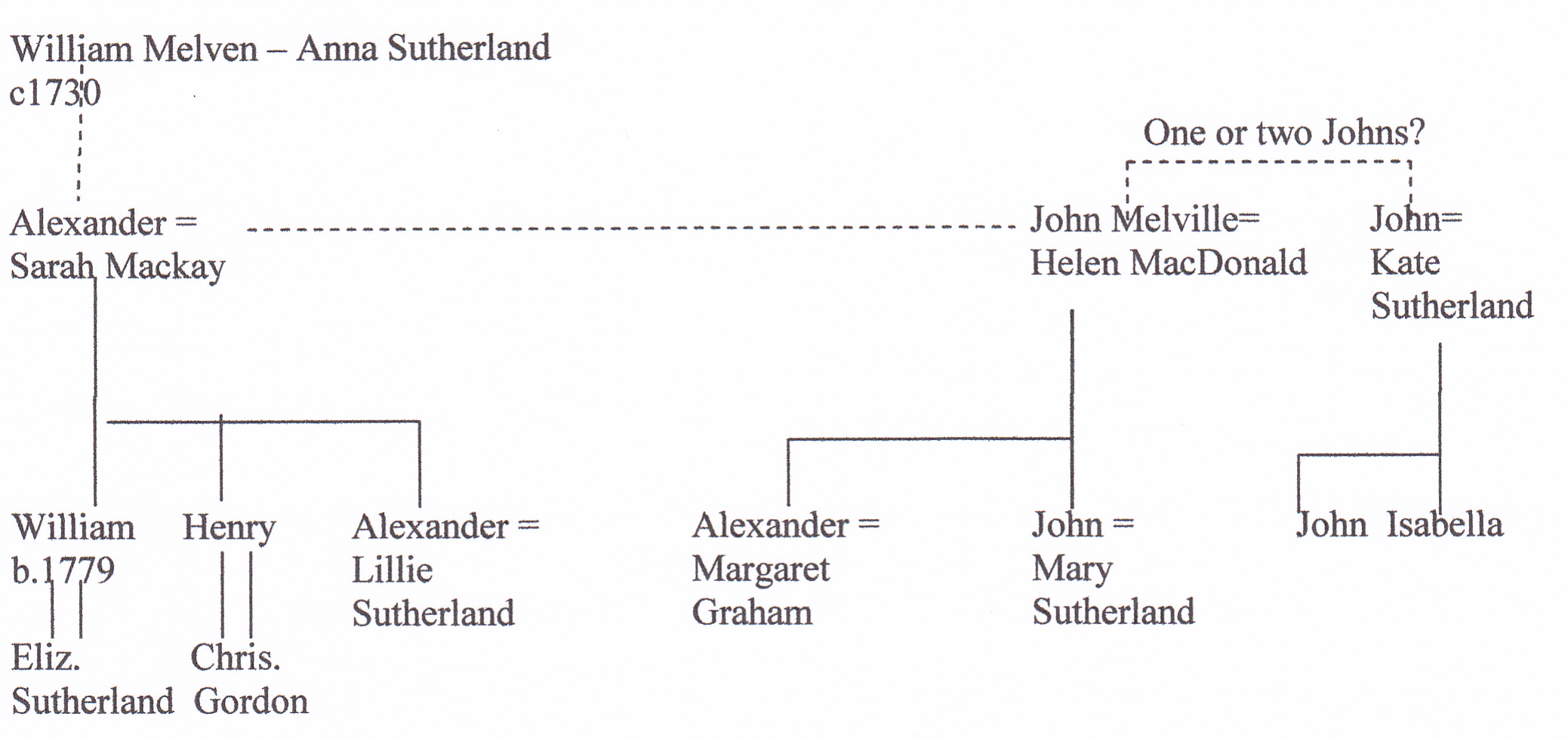
The Henry line is the 'Mainline' or Golspie Melvilles and the John and Mary Sutherland descent is the 'Coalmine Line'.
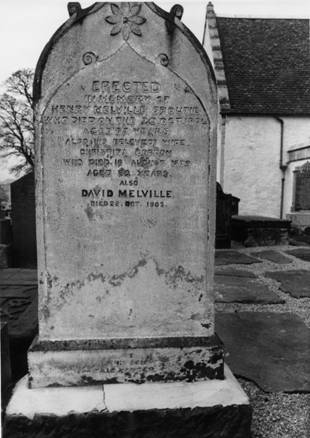
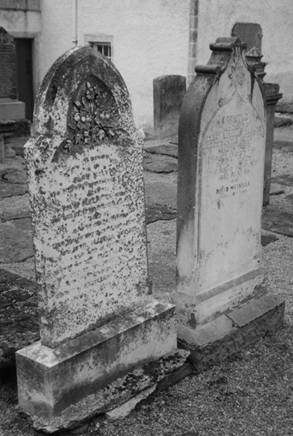
Two
memorials from the 'Mainline' or Golspie Melvilles in
John Melville,
the son of John Melville and Helen MacDonald, married in
Cromarty and returned to the Doll. This
family were the forebears of the 'Coalmine' Melvilles and later
members of this line emigrated to
John's family to Kate Sutherland originated a line connecting to many families still in the Doll and Brora areas including Murrays and McBeaths. In addition to a daughter, Isabella, who was an ancestor of those in the ‘McBeath’ Line, John and Kate had a son John. This John married Elizabeth (Betty) Munro.
The John Melville/Betty Munro descent, or 'Torbeg Line', produced a number of interesting family connections into the other Melville families and other Doll families. It was, however, often dogged by bad luck and illness and never became as widespread locally as my own direct line from Alexander Melville who was born circa 1750. However, those members who did survive and leave the area made good in the antipodes. There is also a line extant in the Doll at the present time.
Regular
correspondence over a period of some years with two avid family
history researchers, Heather and Una Melville, in
The various
ancestors who went to
The
inter-linking of the Melville families in the Doll with their
own lines and with other families seems to have continued in
Some of the
Melvilles of the Doll settled in
A family I
wanted to find much more about held the lease of Crislich at the
head of The Black Water to the upper end of Loch Brora. An
Alexander Melville, son of John Melville and Helen MacDonald,
had at least five children while residing there - John (b.
1806), Katherine (b.1808), Margaret (b.1810), Jean (b. 1814) and
William (b. 1816). The only
tenuous lead I had as my search developed was the marriage of an
Adam Graham Melville in
Since Isabella
and Mary were the daughters of John Melville and Roberta Pope,
the 'Coalmine' family, the other members of this family
including a son Hector and another daughter Davidina went to
Sydney it was certainly possible that my missing family was
cleared from their croft at Crislich and emigrated. The last
reference to Alexander Melville and Margaret Graham found was in
estate papers in 1818 where they received the lease of Crislich
at £60 per year. However,
correspondence from Clearances authority Dr Bangor-Jones, after
he had read an article I wrote for the Highland Family History
Society, indicated
that they had left for
Just when it
appeared that the mystery was never to be solved the word came
from Richard Snedden in
It is worth
pointing out that the marriage of those cousins is yet another
link between Melville lines. However,
it also further suggests that there was a common ancestry for
all the Golspie/Clyne families. Alexander
from Crislich could only have been a ‘cousin german’ or close
cousin, as he was described on Adam and Isabella Melville’s
marriage certificate, if he came through the John Melville and
Helen MacDonald line.
Adam Graham
Melville appears to have been a bit of a character. Married to
two sisters, who were his cousins, and after the death of his
second wife to an Elizabeth McKennery or Trennery. His second
marriage to Mary Melville was in
Another
interesting link within the Australian Melvilles is created by
the marriage of Adam Graham Melville's great grandson to
Christina Leslie who is described as his cousin. The
Leslies were from the Doll but earlier, in
Returning to my
mainline and my more immediate ancestors, while researching in
the Brora records office, Jack MacLennan, the registrar, told me
that he had met great, grandmother Kate 'Roy' Sutherland in the
early twenties as they sheltered at the Iron Bridge at
Strathsteven in a particularly fierce storm. He was
returning to Brora after watching a Boys Brigade football match
in Golspie and she was making her way from her house in the Doll
to visit George Melville and his family at Culmaily. This was a
journey that she made regularly until near the time of her
death. Sometimes
she would follow the line of the road but more often she would
follow the track passing a little inland by the Big Barns and
Dunrobin Farm. I
believe this is close to where, at an earlier time, a prosperous
merchant by the name of Munro operated.
Some speculation on the origins of the Melvilles of the Doll suggested that they were descended from a family of Melvilles who came to work at the Brora coalmine. Further it was thought that the extent in number of the family members was not very great. Both those suppositions have proved to be incorrect with the discovery that the Melvilles were in the area before family members went to work at, and eventually lease, the coalmine and the number of Melvilles in the Doll, Golspie and Brora areas was larger than had been imagined. Not only were the individuals holding the Melville name found to be large in number but also a complicated marriage and inter-marriage structure between the families of the area resulted in many cross-links. So many, in fact, that constructing separate family trees proved extremely difficult and charts became difficult to follow and number in a logical way.
The Sutherland origins of the Melvilles is unresolved at present though I am of the opinion that they were in the area from at least the early 1700s and the first Melville may have, indeed, arrived at the end of the 1600s. A suggestion that they came in with the sheep as shepherds is not sustainable as they were in the area at an earlier stage pre-date most, if not all, the clearances and suffered themselves with the advent of the sheep. In any case, they tended to be lotters, crofters and small farmers and later many were farm labourers as their families grew and the small tenancies could not support all family members.
Since the Melville lines lead back in pyramid form to what appears to be a common ancestor around the time above it is reasonable to speculate that a single family or individual appeared in the area and lines from this source developed but had not become very widespread before records began to be kept of births, baptisms and marriages. In other words, if Melvilles had been in the area for a longer time it is likely that there would have been a number of lines which I could not link back to a single or almost single source. Though there is some uncertainty regarding the number of early John Melvilles the only unidentified Melvilles are females born about the mid-1700s. They could easily be the daughters of William and Ana and sisters to Alexander (c1755) and John (c1750).
Examination of Sutherland Estate records has been of little help in identifying the time of arrival of the Melvilles in the Doll area. To date the records found there for before 1800 are in the lists of rentals and arrears from 1727 and of men able to hold arms in 1745 though there is one reference to a Melville paying a hearth tax in the latter part of the 1600s. The Rental and Arrears lists a Paul Millain at Lothbeg and a Donald and a John Millain at Cracaig. While I have no proof that Millain and Melvin/Melville are synonymous it is certainly possible that we are looking at the same family name. The military records include a John Melvin in Lothbeg, a Paul Melvin in Kintradwell and John Meline in Kilbrora. Those records add further weight to the aforementioned suggestion that Millain and Melvin refer to the same family. In addition, there is a John Melvin listed as a member of Captain Gordon's Militia Company from 17th February 1745 to 1st July 1746. This John may be one of the above mentioned Johns. Whether this indicates other Melvilles in the area prior to William Melven or sons or brothers to this William is uncertain. It does, however, raise the possibility that the Melville families were present on the East Coast of Sutherland at a very early date and that maybe the Doll Melvilles and the Loth/Kildonan Melvilles derive from families in this area between Brora and Loth.
Movement from
the Melville 'homelands' in central
Golspie's Story
by Margaret Grant outlines a number of periods of improvement in
East Sutherland and many of the influences that moulded the
communities along the Sutherland coast. There was
clearly a great deal of movement of people by land and sea into
and through the area and the Melville family could possibly have
arrived in one of those periods of change. It is
possible their arrival was associated with changes at
Not a great
deal is known of fine detail about the 'roots' of great,
grandmother Kate '
The tabulated lines show the descendants of Alexander Sutherland and Jane Murray to be rather more extensive than those of the line on the Matheson/McLean side. However, neither line has been examined closely enough in a 'sideways' direction to reveal the inter-linkages, if they indeed exist, to other families as the extent of those in the Melvilles.
The area of
residence of the Sutherlands after what appears to have been a
move from Strathsteven was in the lower area of the Doll on the
Brora side of the Doll road that leaves the main A9 at Sputie. This is on
the opposite side of the Doll road from Lingmore and Torbeg the
home of some of the Melvilles, including the John Melville and
Betty Munro line. It
is interesting to note that Frasers who married into the
Sutherland line through a cousin of Kate '
The movement of my grandmother Annie Fraser or Ross to Brora with her mother, step-father and step-siblings led to her meeting with George Melville my grandfather. The Ross family moved, as was noted earlier, from Invercassley near Rosehall. Mother Christina Fraser and her husband George Ross had eight children of their own in addition to Annabella Fraser (Annie Ross) by Christina's liaison with John Ross the pupil teacher and crofter.
Christina had
at least five brothers or sisters and was the daughter of
Alexander Fraser (b. 1811) and Ann Black (b. 1809). Alexander
was born in Assynt and his wife was born in Durness, Sutherland
while her parents originated in the Borders having move north
with the sheep at the time of the Clearances. Ann's father
James Black was a shepherd born in Roxburgh and her mother Jane
Turner came from Yetholm.
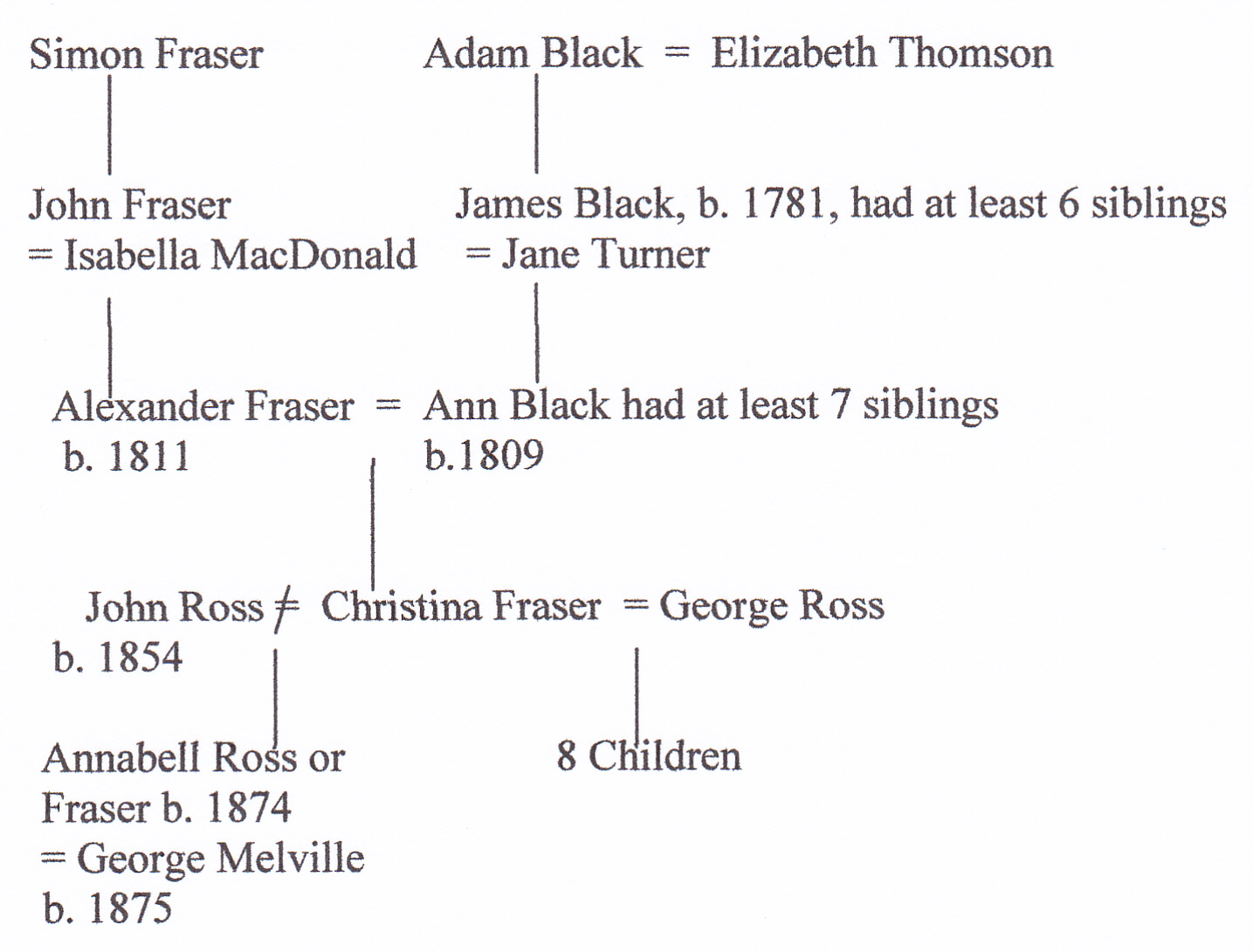
One interesting family member who stayed on at Invercassley was Christina Fraser's brother, John. Old Johnnie, as he was known, was a shoemaker who died aged 91 years at Invercassley in 1930. It is said that he was dead for some days and guarded by his dog before he was found. There is also a suggestion that he may have been mutilated by the dog after his death. The family house in which he stayed was in a ruinous state in 1967 and by the mid-70s it had been raised to the ground. The area now is covered with a new planting of conifers and deciduous trees.
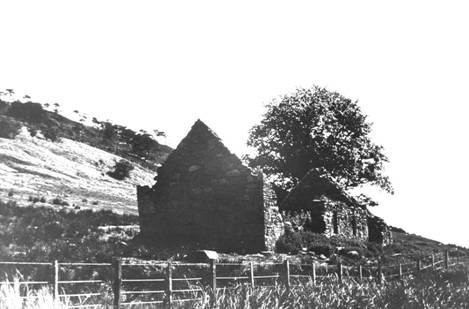
The
Fraser House at Invercassley as it was in 1967.
27/09/2012